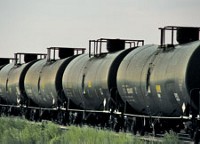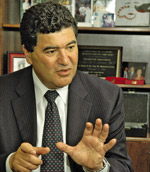Advertisement
Grab your lab coat. Let's get started
Welcome!
Welcome!
Create an account below to get 6 C&EN articles per month, receive newsletters and more - all free.
It seems this is your first time logging in online. Please enter the following information to continue.
As an ACS member you automatically get access to this site. All we need is few more details to create your reading experience.
Not you? Sign in with a different account.
Not you? Sign in with a different account.
ERROR 1
ERROR 1
ERROR 2
ERROR 2
ERROR 2
ERROR 2
ERROR 2
Password and Confirm password must match.
If you have an ACS member number, please enter it here so we can link this account to your membership. (optional)
ERROR 2
ACS values your privacy. By submitting your information, you are gaining access to C&EN and subscribing to our weekly newsletter. We use the information you provide to make your reading experience better, and we will never sell your data to third party members.
Safety
Hazmat Security Stirs Debate
Chemical shippers fight efforts to reroute rail tank cars away from large urban areas
by Glenn Hess
May 14, 2007
| A version of this story appeared in
Volume 85, Issue 20
FEDERAL OFFICIALS have long considered freight railroads that transport highly toxic chemicals to be attractive targets for terrorists. Many rail lines pass through heavily populated corridors, potentially endangering thousands of lives. Some of the industrial chemicals they carry are almost identical to the poison gases used as weapons on the battlefields of World War I, and in 2005, former White House security policy adviser Richard A. Falkenrath told a Senate committee that these substances pose "the single greatest danger of a potential terrorist attack in our country today."

"Right now, we have 90-ton rail tankers carrying toxic chemicals right past some of our nation's largest cities," says Sen. Joseph R. Biden Jr. (D-Del.), who advocates rerouting hazardous shipments away from population centers and other high-threat areas. "We are vulnerable, we know it, and we know how to fix it."
In the wake of the September 2001 terrorist attacks, Biden and other members of Congress charge that federal policymakers have largely ignored the security of the nation's rail transportation systems, while focusing most of their attention on the threat to aviation. In 2006, the federal government spent $4.7 billion for airline security but only $136 million for rail and transit security.
"This threat is not a new one," House Homeland Security Committee Chairman Bennie G. Thompson (D-Miss.) warned shortly before the House passed legislation on March 26 that addresses the funding imbalance. Citing high-profile attacks on rail systems in London, Madrid, and Mumbai over the past three years, he argued that the world's rail and mass transit systems "have been plagued by terrorism for years." And yet, he added, "little has been done here to secure our own systems."
Thompson noted that efforts to secure both freight rail and public transit have lagged far behind airline security and that state and local authorities have largely footed the bill and the responsibility for protecting these essential modes of transportation. "It will cost substantial sums to implement the security measures needed to prevent a possible attack on U.S. rail and public transportation systems," he declared.
The Rail & Public Transportation Security Act of 2007 (H.R. 1401), approved in the House by a vote of 299 to 124, would require rail and public transit systems to assess their vulnerabilities and develop comprehensive security plans for review and approval by the Department of Homeland Security (DHS). The bill authorizes grants of $2.5 billion over four years for rail security and $3.6 billion for public transportation safety.
"Investments to enhance the security of our nation's surface transportation systems have not kept pace with the needs," said House Transportation & Infrastructure Committee Chairman James L. Oberstar (D-Minn.), a cosponsor of the legislation. "We've only invested one penny on mass transit and freight rail security for every seven dollars we have spent on aviation security.
"This month in Iraq, insurgents used chlorine in chemical attacks that killed eight people and made hundreds sick," Oberstar continued. "Chlorine and other chemicals that are even more deadly are shipped through our cities every day. We need to make those shipments more secure."
AIMING TO accomplish that goal, the bill includes an amendment crafted by Rep. Edward J. Markey (D-Mass.) that would require rail carriers hauling "security-sensitive materials" to bypass major cities when more secure alternative routes exist. The requirement would apply only to hazardous materials that, according to the amendment, "pose the greatest danger, such as chlorine or propane."
"We already know that these sensitive chemicals are attractive terrorist targets," Markey told colleagues during debate on the measure. "Every day, tank cars pass through our urban centers carrying enough chlorine to kill 100,000 people in half an hour." Although some of these shipments must travel the routes they currently use, he insisted that others "could easily be safely rerouted to avoid population centers and other areas" that DHS thinks need special security measures. "Whether it's an accident or an al Qaeda attack, we need to make the shipments of deadly chemicals more secure," Markey declared.
Keeping shipments of toxic materials out of high-density population areas is strongly backed by environmental activists, who argue that transportation is one of the domestic sectors most vulnerable to attack or sabotage. "The Markey amendment will eliminate an unnecessary vulnerability for many large urban areas where residents, who now live in the shadow of these deadly cargoes, are at risk," says Rick Hind, legislative director at Greenpeace. "Enactment of rerouting legislation is an essential first step."
Proponents of rerouting are seeking action by Congress because efforts by local governments to bar the rail passage of hazardous substances through their cities have largely failed due to opposition by rail carriers and their customers in the chemical industry. In February 2005, Washington, D.C., became the first city in the nation to adopt a ban on hazmat rail transport, but enforcement of the ordinance has been blocked by a legal challenge. Legislation to prohibit hazardous shipments is pending in at least eight other cities—Albany, Baltimore, Boston, Buffalo, Chicago, Cleveland, Philadelphia, and St. Louis—and sponsors are closely watching the ongoing court fight in the District of Columbia.
Freight railroads and chemical shippers maintain that rerouting hazardous materials does not lessen or eliminate any potential threat???it simply increases and transfers that risk elsewhere on the rail network. Forced rerouting would "foreclose routes that are optimal in terms of overall safety and security, resulting in an increased risk in exposure to hazmat release and reduced safety and security," the Association of American Railroads (AAR) and the American Chemistry Council (ACC) argued in a joint letter sent to all members of the Senate in March.
In successfully lobbying against an attempt by Biden to attach a rerouting mandate to broad homeland security legislation the Senate was considering, the industry groups warned that such a requirement would add "hundreds of miles and additional days to hazmat shipments with the resulting exposure occurring on more circuitous and less suitable routes."
Biden's amendment would have required that any rail shipment containing highly hazardous cargo be rerouted away from "high-threat corridors where intentional attacks are more likely and more casualties are possible." But a motion by Sen. Susan M. Collins (R-Maine) to kill the proposal was adopted by a lopsided vote of 73 to 25 before the Senate on March 13 approved the underlying bill (S. 4), which would implement some of the antiterrorism recommendations of the 9/11 Commission, which was formed after the 2001 terror attacks.
"This provision was a classic example of a solution that sounds good but would ultimately result in undesirable consequences," says Christopher L. Jahn, president of the National Association of Chemical Distributors (NACD). "Requiring rail shipments of hazardous materials to be rerouted around urban areas would cause these shipments to be transported over much longer distances, increasing chances of an incident."
Martin J. Durbin, ACC's managing director of federal affairs, says the industry has been working closely with federal regulators and the railroads to ensure the safe shipment of hazardous chemicals. "ACC and its members and partners have long cooperated and have invested billions of dollars in training, systems, and technology and will continue to do so," he says. "But the idea of trying to somehow either segregate hazardous materials or say you can't bring them through this area or that area won't work. You're really going to bring the whole system to a screeching halt."
Although Markey says his rerouting amendment is narrow in scope and would affect less than 1% of all railcar shipments, industry officials say the language in the House-passed bill could affect any cargo that is required to carry a hazardous materials placard. "Potentially, it could apply to any hazardous material that's shipped," says Thomas E. Schick, ACC's senior director of distribution. In addition to so-called toxic inhalation hazards (TIH) such as chlorine, hydrochloric acid, and anhydrous ammonia, he says the measure would also affect the transportation of radioactive materials, certain categories of explosives, and toxins regulated by the Centers for Disease Control & Prevention. "It's very broad," says Schick. "It goes far beyond shipments of TIH materials."
To become law, a joint House-Senate conference committee will have to reconcile differences between the rail security legislation approved by the House and the 9/11 Commission bill passed by the Senate. Durbin says the Senate's overwhelming, bipartisan rejection of Biden's bid to require rerouting of hazardous shipments suggests that Markey's plan will also encounter stiff resistance in the upper chamber. "It certainly shows that there's going to be some serious discussion about the issue in conference," he remarks. "From our standpoint, we hope the Senate holds firm to its position that rerouting is not something that's appropriate to have in this legislation."
Durbin says also that shippers and carriers will continue to inform lawmakers "about the real-world implications of simply saying that certain areas are now off-limits to moving hazardous materials. Baltimore, for example, may feel safe if it has a restriction. But it may result in more hazardous materials being shipped through Pennsylvania. This is an interstate commerce issue and a safety and security issue that needs to be managed at the federal level."
NACD's Jahn points out that several administrative measures already are under way to improve the security of hazardous materials rail shipments. DHS and the Department of Transportation (DOT) "are conducting a rulemaking that would require carriers and shippers to take substantial new measures to prevent a terrorist attack against railcars containing hazardous materials," he notes. "In addition, legislation is pending in both the Senate and House to enhance these agencies' efforts statutorily."
Under the proposed rules unveiled by the Bush Administration late last year, security protocols would be established to help ensure the safe transfer of TIH materials between chemical manufacturers and freight railroads and to maintain a secure chain of custody throughout the rail transport system. "A toxic emission from an attack against a chemical facility or hazardous chemicals in transit is among the most serious risks facing America's highest threat areas," Homeland Security Secretary Michael Chertoff asserted in announcing the proposed measures on Dec. 15. "We're going to take a significant percentage of that risk off the table."
Chertoff said banning hazardous cargo from urban areas is impractical because many chemical shipments are destined for use in metropolitan areas. "First of all, if you're going to deliver these chemicals, like chlorine—which happens to be very important in purifying water—to a city, you've got to get it into the city," he noted. "And second, to do a lot of rerouting would result, I think, in a substantial reconstruction of the rail industry and the rail network in this country."
The 708 railroads affected by the DHS rules would have to designate security coordinators to receive intelligence from the government and to report significant concerns and potential threats. Carriers would be required to report the precise location of rail shipments when requested by the government in as little as five minutes. And railroads would also have to reduce the amount of standstill time for unattended loaded freight cars, which is when they are considered most vulnerable. Companies that break the rules could be fined as much as $10,000 per violation.
The DHS rule was published along with a related DOT measure that aims to ensure that rail companies send hazardous cargo along routes that pose the least danger for nearby residents. DOT is proposing a regulation that would require railroads to analyze safety and security concerns when determining the route for a freight train carrying certain high-risk hazardous materials, including TIH materials and radioactive substances. "These materials are fueling our economy and are vital to the prosperity of our nation, which is exactly why we want to establish a clear and stronger baseline for determining the safest, most secure way to move them by rail," Transportation Secretary Mary E. Peters remarked in detailing the plan.
Rail carriers would be required to compile annual data clearly identifying route segments and the total number and type of hazardous materials shipments made over each segment. That information would be used to analyze the safety and security risks present on each route. Railroads would then be required to use these data to select the route providing the highest possible degree of safety and security.
Advertisement
SCHICK SAYS the proposed DHS and DOT rules build upon the "significant efforts already undertaken" by ACC's 130-member companies under the organization's own security programs to protect chemical shippers and the nation. "ACC supports the basic initiatives proposed by DOT and DHS to enhance rail transportation security, but we do have some concerns regarding certain provisions and inconsistencies between the two rules," he remarks.
Schick points out that the two agencies have not used identical language in defining which chemical shipments will be subject to the new requirements. The DHS regulation would apply to tank cars, while DOT's proposal would apply to bulk quantities. ACC is urging DOT to apply its route-analysis requirement to tank-car shipments of TIH materials. "We want consistency in what is covered in the TIH area," says Schick. "We think that both carriers and shippers would understand better, and compliance would be facilitated by having a common definition between the two rules of what is covered. If it were up to us, we would prefer the phrase 'loaded tank cars.' "
Regardless of the language, some interest groups contend that the proposed changes in railroad operating procedures do not go far enough to protect the public. Fred Millar, a representative of the environmental group Friends of the Earth, says: "The proposed DHS rule half-heartedly focuses on monitoring and tracking the most dangerous rail cargoes and beefing up physical security in some transfer points. But with 142,000 miles of far-flung track, even AAR admits this is an inherently unsecurable system."
The proposed DOT rule, he notes, would require railroads to analyze and consider risks in their routing of the most hazardous substances. "But chemical shippers and railroads have already considered these risks after 9/11, and in every single city, they have declined to reroute their poison gas cargoes," Millar says. "They are pre-positioning these explosive, radioactive, and poison gas cargoes in our highest threat target areas, exactly where the terrorists want." The most sensible remedy, he contends, is to send the shipments around cities whenever possible and then begin substituting safer chemicals for industrial uses.
AAR President and Chief Executive Officer Edward R. Hamberger says the nation's railroads already have taken steps to bolster security for dangerous cargo. They have increased railcar inspections, set up an operations center to share intelligence with the government, and improved the security of information systems. "We look forward to working with government officials and with those who make and use chemicals in this joint effort to keep our nation safe and secure," Hamberger says.









Join the conversation
Contact the reporter
Submit a Letter to the Editor for publication
Engage with us on Twitter